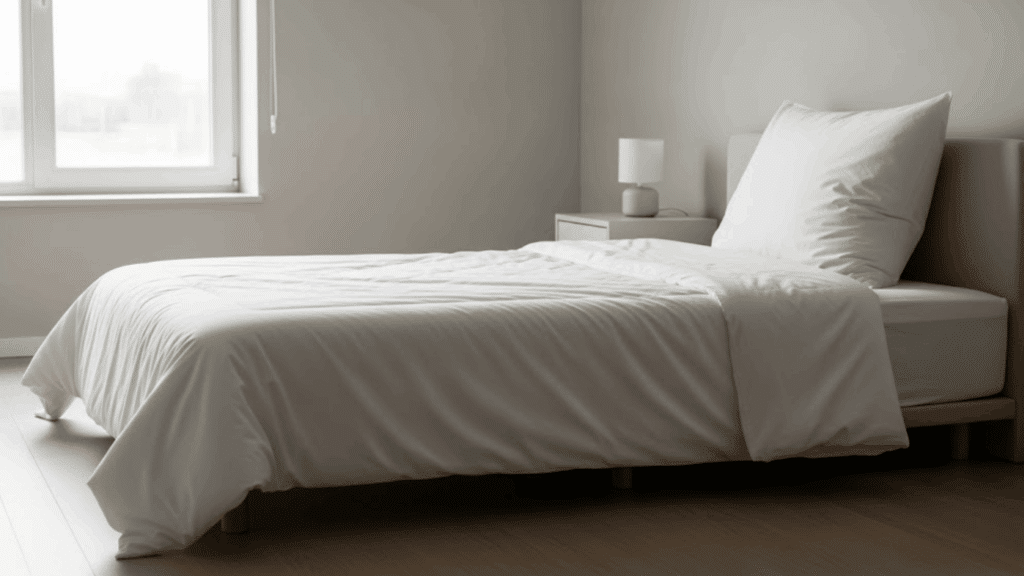Many people love sleeping on their side, but this popular position can lead to painful shoulder problems that disrupt their rest.
If you wake up with aching, stiff shoulders, you’re not alone in this frustrating experience.
Shoulder pain from side sleeping affects millions of people and can seriously impact your sleep quality and daily activities.
The constant pressure and weight on your shoulder joint create problems that get worse over time if left untreated. The good news is that you can take steps to reduce and prevent this pain.
This guide will cover the main causes of shoulder pain from side sleeping, share helpful exercises, and provide practical tips for better sleep positioning.
What Causes Shoulder Pain from Sleeping on Your Side?
Where does the shoulder and arm pain after sleeping on your side come from? Generally speaking, there are several physiological causes of this problem. The most common are:
|
While all of the above conditions can happen regardless of your sleeping position, the truth is that a poor sleeping posture makes things worse.
Side sleeping puts significant pressure on your shoulder joint throughout the night, compressing it against the mattress for hours and reducing blood flow.
Your body weight creates constant pressure that can cause pain, stiffness, and numbness, affecting your sleep quality and daily activities.
Note: Poor sleep positioning affects your entire upper body alignment and can create problems that extend beyond just your shoulder joint.
Prevention of Shoulder Pain from Side Sleeping
You can take several steps to reduce shoulder pain and prevent it from getting worse. Making these changes to your sleep setup and habits can provide significant relief.
- Sleep on your back when possible – Eliminates pressure on both shoulders completely
- Choose the non-painful side – If you must side sleep, avoid the affected shoulder entirely
- Use body pillows for support – Place between legs and arms to prevent stress on shoulder joints
- Select proper pillow height – Should fill neck gap without pushing head too high or too low
- Choose a medium-firm mattress – Provides a balance of pressure relief and spinal alignment support
- Apply heat or ice therapy – 15-20 minutes of heat for stiffness or ice for acute pain and swelling
Exercises to Help Reduce Shoulder Pain
Regular exercise can strengthen your shoulder muscles and improve flexibility to reduce pain from side sleeping. Perform these exercises gently and stop if you feel increased pain.
1. Shoulder Blade Squeeze
This exercise strengthens the muscles between your shoulder blades and improves posture. Repeat 10-15 times, focusing on feeling the muscles work between your shoulder blades.
Steps:
- Sit or stand with your back straight and arms at your sides
- Pull your shoulder blades together toward your spine
- Squeeze and hold this position for 5 seconds
- Slowly release and return to the starting position
Benefits: Strengthens the muscles between your shoulder blades and improves posture.
2. Scapular Retraction
This exercise strengthens your upper back muscles and helps counteract rounded shoulder posture from sleeping. Perform 2-3 sets of 10 repetitions throughout the day for best results.
Steps:
- Stand or sit with good posture, arms at your sides
- Pull your shoulder blades back and down simultaneously
- Keep your arms relaxed at your sides during the movement
- Hold this position for 5 seconds before relaxing
Benefits: Strengthens your upper back muscles and helps counteract rounded shoulder posture from sleeping.
3. Doorway Chest Stretch
This stretch helps counteract the forward shoulder posture that can develop from side sleeping positions. Make sure to breathe deeply during the stretch and avoid bouncing or forcing the movement.
Steps:
- Stand in a doorway and place your forearm against the frame
- Position your arm at a 90-degree angle (elbow at shoulder height)
- Step forward with the opposite foot until you feel a stretch across your chest
- Hold for 30 seconds, breathing deeply
- Switch arms and repeat on the other side
Benefits: Helps counteract the forward shoulder posture that can develop from side sleeping positions.
4. Cross-Body Shoulder Stretch
Pull your affected arm across your chest with your other hand and hold for 30 seconds. You should feel a gentle stretch in the back of your shoulder.
This stretch helps improve flexibility and reduce tension in the shoulder muscles.
Steps:
- Stand or sit with good posture
- Bring your affected arm across your chest toward the opposite shoulder
- Use your other hand to gently pull the arm closer to your body
- Hold for 30 seconds, feeling a gentle stretch in the back of your shoulder
- Release and repeat on the other side
Benefits: Helps improve flexibility and reduce tension in the shoulder muscles.
5. Pendulum Shoulder Stretch
Let your affected arm hang down loosely and gently swing it in small circles. Keep the movements smooth and controlled without forcing the motion.
This helps maintain shoulder mobility without putting stress on the joint structures.
Steps:
- Stand next to a table or chair for support
- Lean forward slightly and let your affected arm hang down loosely
- Use your body to create gentle momentum, swinging your arm in small circles
- Keep movements smooth and controlled without forcing the motion
- Switch directions after 30 seconds
Benefits: Maintains shoulder mobility without putting stress on joint structures.
6. Arm Circles
Make small forward and backward circles with your arms extended to the sides. Start with small circles and gradually increase the size as your shoulder feels more comfortable.
This exercise improves shoulder mobility and increases blood flow to the area.
Steps:
- Stand with your feet shoulder-width apart
- Extend both arms out to your sides at shoulder height
- Start making small forward circles with both arms
- Gradually increase the size of circles as your shoulders feel comfortable
- After 10 circles, reverse direction for backward circles
Benefits: Improves shoulder mobility and increases blood flow to the area.
7. Thread-the-Needle Stretch
Start on your hands and knees, then thread one arm under the other and reach across your body. Hold the stretch for 15-20 seconds before returning to the starting position.
This stretches multiple shoulder muscles and improves flexibility in different directions.
Steps:
- Start on your hands and knees in a tabletop position
- Lift one arm and thread it under the opposite arm
- Reach across your body as far as comfortable
- Allow your shoulder and head to lower toward the floor
- Hold the stretch for 15-20 seconds
- Return to the starting position and repeat on the other side
Benefits: Stretches multiple shoulder muscles and improves flexibility in different directions.
8. Eagle Arms Stretch
Wrap one arm under the other and try to touch your palms together if possible. This stretch targets the back of your shoulders and upper back muscles that can become tight from side sleeping.
Steps:
- Stand or sit with your arms in front of you
- Cross one arm under the other at the elbows
- Bend both elbows and try to wrap your forearms around each other
- Attempt to touch your palms together if possible
- Hold this position for 20-30 seconds
- Release and switch which arm is on top
Benefits: Targets the back of your shoulders and upper back muscles that can become tight from side sleeping.
9. Neck, Shoulder, and Upper Back Yoga
Gently roll your neck in slow circles and shrug your shoulders up and down. Perform these movements slowly to avoid causing additional strain.
This helps release tension in your neck and upper back that often contributes to shoulder pain.
Steps:
- Sit or stand with good posture
- Slowly roll your neck in small circles, first clockwise, then counterclockwise
- Shrug your shoulders up toward your ears, hold for 2 seconds, then release
- Roll your shoulders backward in slow, controlled circles
- Perform these movements slowly to avoid causing additional strain
Benefits: Releases tension in your neck and upper back that often contributes to shoulder pain.
10. Shoulder Rolls
Roll your shoulders forward and backward in smooth, controlled circles. Focus on making the movement slow and deliberate rather than quick or jerky.
This exercise improves circulation and reduces stiffness in your shoulder joints.
Steps:
- Stand or sit with your arms relaxed at your sides
- Slowly roll your shoulders forward in large, controlled circles
- Focus on lifting your shoulders up, forward, down, and back
- Complete the forward rolls, then reverse direction
- Roll your shoulders backward using the same controlled movement
Benefits: Improves circulation and reduces stiffness in your shoulder joints.
11. External Rotation with Resistance Band
Use a light resistance band to perform external rotation exercises with your affected arm. Keep your elbow at your side and rotate your arm outward against the band’s resistance.
This strengthens the small stabilizing muscles that support your shoulder joint during movement and sleep.
Steps:
- Hold a light resistance band with both hands
- Keep your elbows at your sides, bent at 90-degree angles
- Keep one arm stationary while rotating the other arm outward
- Rotate against the band’s resistance, moving slowly and controlled
- Return to the starting position and repeat
- Switch to the other arm after completing your set
Benefits: Strengthens the small stabilizing muscles that support your shoulder joint during movement and sleep.
Important Safety Tips
- Start slowly: Begin with gentle movements and gradually increase intensity
- Stop if painful: Discontinue any exercise that causes sharp or increased pain
- Be consistent: Perform these exercises daily for best results
- Warm up first: Do gentle arm swings or shoulder rolls before starting
- Cool down: Hold gentle stretches for 30 seconds after completing exercises
These exercises work best when performed regularly as part of a daily routine. If shoulder pain persists or worsens, consult with a healthcare professional or physical therapist for personalized guidance.
Best Sleeping Positions for Shoulder Health
Choosing the right sleeping position can prevent shoulder pain and help existing pain heal faster. These positions reduce pressure on your shoulder joints.

1. Back Sleeping
Back sleeping is the best position for shoulder health because it eliminates pressure on both shoulders. Use a supportive pillow under your knees to maintain your spine’s natural curve.
Place a small pillow or rolled towel under your affected arm for extra support. This prevents your arm from falling to the side and straining your shoulder.
2. Modified Side Sleeping
If you can’t sleep on your back, side sleep on your non-painful shoulder. Use a body pillow or regular pillow between your arms to support your top arm and prevent it from falling across your body.
Keep your affected arm slightly in front of your body rather than under your head or pillow. This reduces compression and maintains better circulation.
3. Positions to Avoid
Never sleep directly on your painful shoulder, as this increases inflammation and delays healing. Avoid placing your arm under your head, pillow, or body weight.
Don’t sleep with your arms overhead, as this can impinge on shoulder structures and worsen pain. Keep your arms in a neutral position beside your body or slightly in front.
Long-Term Effects of Side Sleeping on Shoulders
Continuing to sleep on a painful shoulder can lead to serious long-term problems that become harder to treat over time. Understanding these risks motivates better sleep habits.
| Condition/Impact | What Happens | Consequences |
|---|---|---|
| Chronic Shoulder Impingement | Soft tissues become permanently pinched between bones | Ongoing pain and limited range of motion |
| Rotator Cuff Injuries | Develop or worsen from constant compression during sleep | Often require physical therapy or surgery to repair |
| Shoulder Bursitis | Fluid-filled sacs stay inflamed from repeated pressure | Persistent pain and stiffness affecting daily activities |
| Sleep Quality Disruption | Shoulder pain interrupts restful sleep patterns | Daytime fatigue and reduced ability to concentrate |
| Healing Process Impact | Poor sleep slows your body’s natural healing | Recovery takes longer and may be incomplete |
| Daily Activity Limitations | Pain affects lifting, reaching, and carrying objects | Impacts work performance and overall quality of life |
Note: Early intervention with proper sleep positioning and exercises can prevent most of these long-term complications from developing.
Taking Control of Your Shoulder Pain
Shoulder pain from side sleeping doesn’t have to control your nights and days.
With the right combination of proper sleep positioning, regular exercise, and supportive bedding, you can significantly reduce or prevent this common problem.
Start by making simple changes to your sleep setup – use supportive pillows, choose the right mattress firmness, and avoid sleeping on your painful shoulder.
Add the recommended exercises to your daily routine to strengthen and stretch your shoulder muscles.
If pain persists or worsens despite these changes, don’t hesitate to seek professional help from a physical therapist or doctor.
Share your experience in the comments – your success story could inspire others to find relief too!
Frequently Asked Questions
Should I Sleep on My Painful Shoulder or the Other Side?
Always sleep on your non-painful side to avoid putting pressure on the injured shoulder and allow it to heal.
How Long Does Shoulder Pain from Side Sleeping Take to Heal?
With proper positioning and exercises, mild shoulder pain often improves within 1-2 weeks, but severe cases may take several months.
When Should I See a Doctor for Shoulder Pain from Sleeping?
Consult a healthcare provider if pain persists for more than a few weeks, worsens despite changes, or limits your daily activities.





